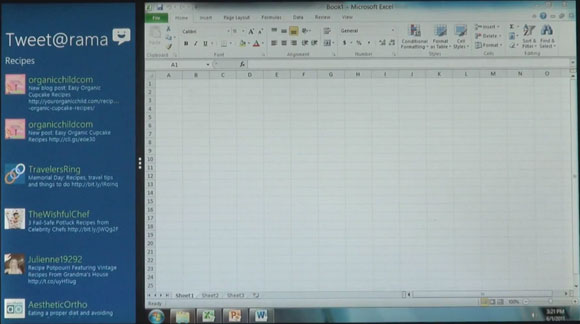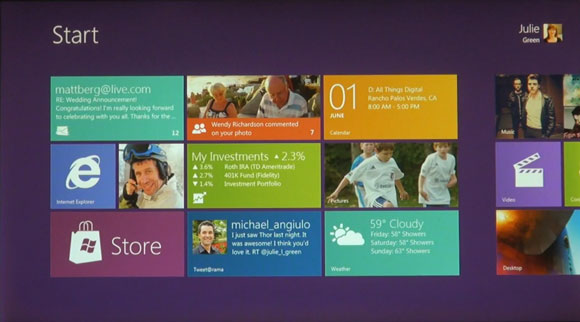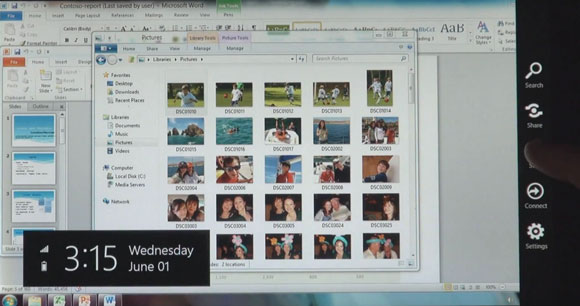 This week at the All Thing Digital D9 Conference, Microsoft's Steven Sinofsky showed off the next version of Windows, codenamed Windows 8. The fresh new UI that they demonstrated is intended to be the new default screen when users log into a Windows 8 machine. The design is very much in line with Microsoft's "Metro" interface, something that debuted on desktop apps and became the default experience on the Zune HD and now Windows Phone 7. Instead of the traditional Windows desktop, what users now see is a series of tiles laid horizontally. These tiles can represent anything, from applications to specific files to websites, etc. In this sense, the utility of the new Start screen is very similar to Windows Phone 7, where the tiles define the experience and the primary way to move in and out of tasks.
This week at the All Thing Digital D9 Conference, Microsoft's Steven Sinofsky showed off the next version of Windows, codenamed Windows 8. The fresh new UI that they demonstrated is intended to be the new default screen when users log into a Windows 8 machine. The design is very much in line with Microsoft's "Metro" interface, something that debuted on desktop apps and became the default experience on the Zune HD and now Windows Phone 7. Instead of the traditional Windows desktop, what users now see is a series of tiles laid horizontally. These tiles can represent anything, from applications to specific files to websites, etc. In this sense, the utility of the new Start screen is very similar to Windows Phone 7, where the tiles define the experience and the primary way to move in and out of tasks.
Make no mistake about it, this new look and feel to Widows is the biggest change Microsoft's OS since Windows 95. The ideas behind it and the look and feel are absolute upgrades that make Windows feel truly modern. The most obvious goal of the new interface is that it's clearly built for touch and for use on tablets. Unfortunately, the approach that Microsoft is taking is a unified approach that demands that every Windows tablet will run a full version of Windows with this new layered interface on top. This strategy is fundamentally flawed from a technical perspective, but what is far worse is that it is strategically harmful to the core ecosystems that Microsoft is trying to build and maintain. With this one strategic move, Microsoft is stunting meaningful progress in three product categories: Desktops, tablets and smartphones.
Windows Desktop
With this new interface and approach, Microsoft is essentially halting meaningful progress on their desktop Windows experience. There's no question that Windows 7 was a commercial and critical success. It was a commercial success by default because Windows has such an enormous installed user base, and it was a critical success because it picked up the pieces from Windows Vista and turned out to be a solidly improved experience. Other than a few key UI tweaks, most notably the improved taskbar, Windows 7 was nothing more than a polished version of the disappointing Windows Vista. At the end of the day, the user experience hasn't really changed since Windows 95, and industry observers have been calling for something exciting for some time. It's a shame that Microsoft has chosen this direction for Windows 8, because it's actually a misstep in two ways.
Just as Google seems distracted by the tablet in improving Android, Microsoft seems overwhelmed by the storm of criticism for not putting out a competitive touch-based operating system. Instead of delivering this new Start menu and touch-based UI in the form of a new tablet OS, Microsoft is currently pitching the new interface as the default interface that each new system will ship with. I say "currently" because I expect that will change as the launch gets closer and enterprise customers and OEMs complain. The problem with this approach is that the new UI, though attractive, seems very unappealing to use on a traditional computer. There's hardly any advantage offered by the tile-based Start screen, and the large icons are derivative of touch-based systems that don't have the advantage of cursor or keyboard. On a traditional desktop, the new Start screen is wasted space that offers no real utility. What is the purpose of live tiles if you can't see them all at once like you could with a desktop widget/gadget? Why have a lock screen that shows information when someone is already sitting down at the computer to do something, rather than pulling their phone out of their pocket to quickly check something?

Of course, Microsoft hasn't fully committed to this new interface and offers a way to quickly return to the traditional Windows desktop. That would be all well and good if Windows 7 was a perfect desktop OS that didn't need improvements in its own right. What they showed at D9 was a desktop environment that looks identical to Windows 7 with no notable improvements. Microsoft is certain to make some changes before Windows 8 rolls out, but if we're being honest they aren't likely to be revelatory. The Windows team is clearly focused on moving Windows towards this new paradigm and porting Windows to ARM processors. It's unlikely that they're going to have the time or manpower to radically change the desktop, and that's unfortunate given that Windows still has major issues with window management, different installers, 3rd-party application consistency and a myriad of other issues that Mac OS X seems to have figured out. This focus on making Windows fit this tablet UI is going to have the effect of essentially slowing down meaningful progress on Windows.
Not that this is going to have any effect on Microsoft's dominance in the desktop marketplace. They still hold an insurmountable lead and no matter how fast the Mac is growing, it's unlikely to impact Microsoft's bottom line in a significant way. This will affect Microsoft's hardware partners more than anything, since they will continue to be uncompetitive in the $1,000+ space and increasingly feel the pressure on the low end by the growing number of tablet-like devices. Sadly, Microsoft is not offering much to help them out on the tablet front either.
Windows Tablets
After years of waiting, the world will finally get Microsoft's answer to the iPad in 2012. It's not a lightweight operating system like iOS or Android. It's not an expansion of Windows Phone. No, Microsoft's answer is to deliver a full Windows PC with a touch-friendly layer on top. The PR coming out of Microsoft insists that this is not just a skin or shell, but if you can touch one button to launch into the full Windows desktop, it's a skin. If you can push an icon for Microsoft Office and immediately launch into a traditional Windows app, complete with scroll bars, close buttons and the Start Menu in the corner, it's a skin. Microsoft's answer to the iPad is a PC with the same baggage underneath that has killed the battery life and performance of every Windows tablet that's ever been shipped. The difference, it seems, is this new Start menu and the types of applications that can be created for the new environment.
So what types of apps can developers now code for this tablet-optimized environment? Can they make rich, native apps like the ones on iOS that set iOS apps apart from Android apps? The answer is no. What they can write are apps written in HTML5 and Javascript. These web languages have been tried before as exclusive development environments with disastrous results. Palm's WebOS was the most notable example, but it didn't take Palm long to realize they had to open up to native development. Even Windows Phone isn't limited to web languages. Windows Phone developers can write in Silverlight, a development framework that works on desktop Windows as well. In all likelihood, Microsoft is limiting the development environment because they can't do anything more for their touch experience at this time, but that makes it no less sad.
What does this all boil down to? Microsoft is shipping a tablet OS that is not actually optimized for tablets because it runs the entire, bloating Windows OS. This puts tremendous pressure on the hardware and will most likely result in unfavorable comparisons when sized up against the available offerings from Apple and Google. Meanwhile, the ability to run Windows will result in a disjunct experience where applications don't look right side by-side. Just look at the picture at the top of this article. And to top it all off, this insistence on putting a shell over the existing Windows experience leads to a limited development framework for the tablet that is incapable of creating rich applications. If you are a Windows developer and knew that every Windows tablet would have both environments, which environment would you code for? You would use the traditional tools from Microsoft that have given rise to the most dominant software platform on the planet. After all, they're not letting you create native touch-based apps.

Windows Phone
Lost in all of this excitement is Windows Phone, a genuinely exciting offering from Microsoft that is attractive and headed for true competitiveness once the Mango update hits in the fall. Windows Phone shares so much with Windows 8 in terms of design, but is clearly the odd man out of these three categories. Consider that Apple chose to make iOS the singular framework for both the iPhone and the iPad. They did this for two simple reasons; the iPad is a touch-based mobile OS, just like the iPhone, and this is now a game of ecosystems. Having major synergy between the iPhone and iPad helps iOS developers and helps Apple maintain developer support. Microsoft absolutely could have delivered tablets based on the Windows Phone OS. Instead, they've decided to align their tablets with desktop Windows, further stranding Windows Phone in its battle to gain market relevance.
Why is this a mistake? The tablet market has yet to be defined as a true productivity successor to the desktop. Right now, the most important and fierce battle in computing is in the mobile space. At a time when Microsoft is falling too far behind in phones, they've chosen not to help the ecosystem. If Windows Phone is not successful, it will severely hurt Microsoft's future success, regardless of how well "Windows" does in the short term. If lightweight operating systems like iOS, Android or WebOS are in everyone's pockets 5 years from now, it will be much harder for Microsoft to make the case that their Windows tablets are essential just because they run legacy apps. Microsoft will end up regretting practically ceding the phone market and not doing everything it can to help it.
Supporting a dying legacy
Given that Windows Phone runs on ARM, it's particularly odd that Microsoft chose to take this approach. While legacy apps will run on their Intel-based tablets, Microsoft has already announced that legacy apps will not work on the version of Windows 8 that will be ported to ARM. If they are going to have tablets on the market that don't run legacy, then why bother insisting that desktop Windows is in every installation of Windows? They are essentially insisting on legacy app support and all the downsides of that, even though many of these devices won't run these apps because they'll be built on ARM architectures. It shows a disturbing lack of confidence on Microsoft's part and an inability to see beyond the scope of Windows as a significant revenue stream.
Whether it's to protect their current business model or because of a lack of technical ability, Microsoft is putting a clear stake in the ground and signaling how they view tablets and the next generation of Windows. Microsoft is hoping that even though they are coming to the tablet market late they will be able to sell their approach by offering a full computing experience underneath the consumer-friendly tablet layer. For some people, this will prove to be a selling point, and there's no question that the Metro UI that they've chosen is attractive and inviting. What's going to happen, though, is that enterprise customers will be turned off by the new UI, consumers will be underwhelmed by the encroaching presence of desktop Windows and Windows Phone fans will be left languishing in an unsupported ecosystem.
It's impossible to write this without drawing a comparison to Apple, who will announce the new versions of both Mac OS X and iOS tomorrow. Apple's iPhone and iPad ecosystem is thriving and they are not swinging too far to the extreme in bringing iOS elements to their desktop OS. While Lion carries over some familiar elements of iOS, Apple is still clearly differentiating the two types of experiences, and rightly so. Microsoft can't afford to lose in mobile, yet they're doing everything they can to be bogged down by their devotion to Windows.
***Addendum: It bears mentioning that this article was outlined in Text Edit on a Mac which was then put into Dropbox, started in Pages on the iPhone, emailed by Gmail to myself, downloaded on a Macbook Air, entered in to Wordpress and then finished in Wordpress on an iMac. While that's an unusual workflow and perhaps not ideal, it's worth mentioning that the process didn't come close to touching the Microsoft ecosystem. This is the challenge they face going forward in mobile where the lock-in to one platform doesn't exist.